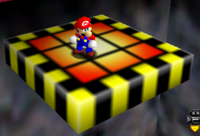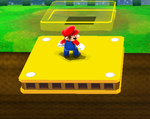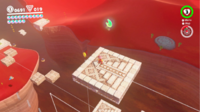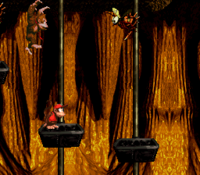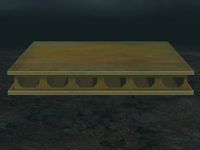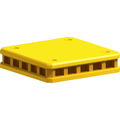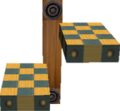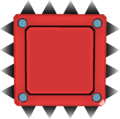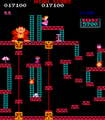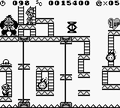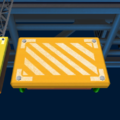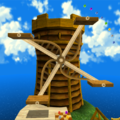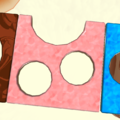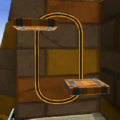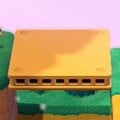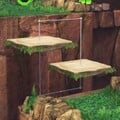Lift: Difference between revisions
LinkTheLefty (talk | contribs) |
|||
| (297 intermediate revisions by 83 users not shown) | |||
| Line 1: | Line 1: | ||
{{rewrite| | {{rewrite-expand|have information on Flatbed Ferries' appearance in ''[[Super Princess Peach]]''}} | ||
{{redirect|Elevator|the object in [[Donkey Kong's Crash Course]] in [[Nintendo Land]]|[[Automated elevator]]|the object in [[Super Mario Land]] also referred to as an Elevator|[[Lift Block]]}} | |||
{{item infobox | |||
|image=[[File:Lift CTTT.png|x200px]]<br>Artwork from ''[[Captain Toad: Treasure Tracker]]'' | |||
|first_appearance=''[[Donkey Kong (game)|Donkey Kong]]'' ([[List of games by date#1981|1981]]) | |||
|latest_appearance=''[[Mario vs. Donkey Kong (Nintendo Switch)|Mario vs. Donkey Kong]]'' ([[Nintendo Switch]]) ([[List of games by date#2024|2024]]) | |||
}} | |||
'''Lifts'''<ref>{{cite|author=Pelland, Scott; Owsen, Dan|title=''Super Mario 64 Player's Guide''|location=Redmond, WA|publisher=[[Nintendo|Nintendo of America]]|date=1996|page=58}}</ref><ref>''Super Mario Maker'' in-game name</ref> (also known as '''elevators''')<ref>{{cite|author=Musa, Alexander; Hatchett, Geson|title=''Super Mario 3D World'' PRIMA Official Game Guide|page=167|publisher=Prima Games|language=American English|date=November 22, 2013|isbn=978-0804162494}}</ref><ref>''Mario vs. Donkey Kong 2: March of the Minis'' in-game help (no. 08)</ref> are thin platforms that appear throughout the [[Super Mario (franchise)|''Super Mario'' franchise]]. They typically are suspended in the air and move, enabling the player character or to reach different heights and cross gaps. Some move by themselves, while others are controlled by the player. | |||
[[ | Lifts that move along wire-like [[track]]s in the ''[[Super Mario (series)|Super Mario]]'' and ''[[Yoshi's Island (series)|Yoshi's Island]]'' series are sometimes referred to as '''Flatbed Ferries'''.<ref>{{cite|quote=Stand on the Flatbed Ferry platform above this first Star Coin, and wait for the Flatbed Ferry to slide to the right.|author=Stratton, Steve|isbn=978-0-307-89690-2|title=''New Super Mario Bros. U: PRIMA Official Game Guide''|location=Roseville|publisher=[[Prima Games]]|date=2012|page=68}}</ref> | ||
'' | |||
==History== | ==History== | ||
===''Donkey Kong''=== | |||
In ''[[Donkey Kong (game)|Donkey Kong]]'', two sets of lifts appear in [[75m]]: one set going up, the other set going down. Lifts appear to work via a chain-like mechanism. When an elevator reaches the end of its path, it disappears, and a new one appears at the beginning of the path, as opposed to a single elevator going up and down. | |||
In ''[[Donkey Kong (game)|Donkey Kong]]'', two sets of | |||
Lifts also appear in the [[Game Boy]] version of ''[[Donkey Kong (Game Boy)|Donkey Kong]]''. Levers can be pulled in certain levels to make them change direction. | |||
===''Super Mario'' series=== | |||
====''Super Mario Bros.'' / ''Super Mario Bros.: The Lost Levels''==== | |||
[[File:SMB NES World 6-3 Screenshot.png|frame|Mario riding a lift in ''[[Super Mario Bros.]]'']] | |||
[[File:SMBPlatform.png|frame|left]] | |||
Lifts are common in some levels of ''[[Super Mario Bros.]]'' '''Vertical Lifts'''<ref name=Win>{{cite|author=Tochikubo, Hiroo|title=''[[How to win at Super Mario Bros.]]''|publisher=Tokuma Shoten|date=1987|isbn=4-19-720003-XC|page=47}}.</ref> first appear in [[World 1-2 (Super Mario Bros.)|World 1-2]], where they continuously move upwards or downwards with new ones being dispensed from the bottom or top. [[World 1-3 (Super Mario Bros.)|World 1-3]] introduces a version of this lift that remains onscreen and simply moves up and down, as well as '''Horizontal Lifts'''<ref name=Win/> that move back and forth. [[World 3-3 (Super Mario Bros.)|World 3-3]] introduces [[Flimsy Lift]]s, which are stationary lifts that move downwards if [[Mario]] or [[Luigi]] stands on them, as well as [[Scale Lift|Balance Lift]]s. Balance Lifts consist of two platforms attached to a pulley, where if Mario/Luigi stands on one of them, that lift is weighed down, while the other is hoisted upwards. However, if Mario/Luigi stands on said lift too long, and the lift he is on moves too far down due to his weight, then both lifts will break off the pulley and fall into the void below, causing Mario/Luigi to score 1,000 points, oddly enough. The lifts are solid, meaning Mario and Luigi cannot land on top by jumping through them. Their original visual appearance in ''Super Mario Bros.'' is likely derived from the appearance of the platforms that make up [[100m]] in ''Donkey Kong'', while, in ''[[Super Mario Bros.: The Lost Levels]]'', they are made of mushrooms. However, in the ''[[Super Mario All-Stars]]'' version, both games feature them in their normal form. | |||
====''Super Mario Bros. 3'' / ''Super Mario Advance 4: Super Mario Bros. 3''==== | |||
In ''[[Super Mario Bros. 3]]'', lifts are made of wood, much like [[Hard Block]]s in the game. Two new varieties are introduced: '''Rail Lifts''',<ref>''Super Mario Bros. 3'' English instruction booklet. Page 19.</ref> which travel along a track, first appearing in [[World 1-6 (Super Mario Bros. 3)|World 1-6]], and moving Flimsy Lifts, which fall all the way to the bottom of the screen as soon as Mario or Luigi lands on one, first appearing in [[World 1-4 (Super Mario Bros. 3)|World 1-4]]. In ''[[Super Mario Advance 4: Super Mario Bros. 3]]'', ''Super Mario Bros.''-styled metallic lifts of various types are found in the [[World-e]] levels [[Wild Ride in the Sky]], [[Caped Escape]], [[Koopaling Confusion]], [[Classic World 1-2]], [[Classic World 1-3]] and [[Classic World 1-4]], while several stationary lifts in their ''Super Mario World'' design can be seen in the level [[Rich with Ropes]]. In [[A Towering Tour]], some fast-moving gray-colored lifts also appear. They behave similarly to the metal lifts, only being shaped like the normal lifts, and the aforementioned color difference. They also follow a shorter path compared to normal lifts, which adds to the difficulty of staying on top of them. These blocks also have a line-guided variant, which move even faster than their non-line-guided variants. | |||
====''Super Mario World'' / ''Super Mario World: Super Mario Advance 2''==== | |||
Lifts reappear in ''[[Super Mario World]]'' and [[Super Mario World: Super Mario Advance 2|its reissue]], this time with a gray or cream color. The Rail Lift is back under the name '''Pulley Lift'''<ref>{{cite|author=Nintendo of America staff|title=''[[Mario Mania]]''|page=70 and 71|date=August 1991|language=American English|publisher=[[Nintendo Power]]}}</ref> (or '''Pully Lift''').<ref>{{cite|title=''Nintendo Power Advance'' Volume 4|date=2002|page=29|publisher=Nintendo of America|language=American English}}</ref> A platform on a swing is known as a [[Single Swing Lift]], coming with a brown version that activates and rotates around a central pivot point when a player steps on it and a gray version that swings in perpetual motion, as well as a set of three swinging gray platforms known as a [[Triple Swing Lift]]. A set of gray [[Rotating Block]]s that cannot spin with wings is known as a [[Flying Platform]]. A raft of skulls on lava is known as a [[Lava Lift|Skull Raft]]. An orange, diagonal-facing lift with a grassy top is known as a [[diagonal platform]], and a thicker, upright grassy platform with a countdown timer in the middle is known as a [[Count-Lift]]. Additionally, a mushroom variant of the Balance Lift is known as a [[Piston Lift]]. | |||
====''Super Mario Land 2: 6 Golden Coins''==== | |||
''[[Super Mario Land 2: 6 Golden Coins]]'' introduces a [[Bone Lift]] that rises upward when jumped on, which is a hazard as the sole section of the game that includes them features [[Spike Trap|spike]]s above them. They basically act as the opposite of the Flimsy Lift, although the Bone Lift freezes in place when Mario is off of it, unlike the Flimsy Lifts in this game. | |||
====''Super Mario 64'' / ''Super Mario 64 DS''==== | |||
[[File:Elevatortour.png|thumb|left|Mario on a lift in ''[[Super Mario 64]]'']] | |||
[[File:SM64 Elevator.png|thumb|right|Mario on an elevator in ''Super Mario 64'']] | |||
Most lifts in ''[[Super Mario 64]]'' and ''[[Super Mario 64 DS]]'' have a tan-and-green checkerboard pattern on them. In some courses, such as [[Whomp's Fortress]] and [[The Secret Under the Moat|Vanish Cap Under the Moat]], pairs of lifts move along and rotate around both sides of a vertical beam, flipping when they reach the top. In the [[Hazy Maze Cave]] and [[Lethal Lava Land]], lifts move along chains of black spheres when stepped upon. Additionally in the Hazy Maze Cave, large orange lifts with yellow and black trim appear to take the player between floors, and a unique controllable lift called the [[Work Elevator]] appears in one part of the course. Special lifts called [[Arrow Lift (Super Mario 64)|Arrow Lift]]s appear in [[Wet-Dry World]], moving back and forth when stepped upon. Also in Wet-Dry World, an '''Express Elevator''' appears embedded into some metal mesh. Stepping on the portion outside the mesh causes it to lower, at which point the player has a limited time to reach the portion inside the mesh and ride it to a [[Power Star]]. In [[Tick Tock Clock]], yellow rectangular lifts move up and down; the speed and direction vary depending on the time Mario enters the course. Also, a brown cube that moves up and down serves as an obstacle during [[The Pit and the Pendulums]], and Mario can step on it. | |||
{{br|left}} | |||
====''Super Mario Galaxy 2''==== | |||
[[File:SMG2 Lift Platform.png|thumb|150px|Mario on a lift in ''Super Mario Galaxy 2'']] | |||
In ''[[Super Mario Galaxy 2]]'', lifts appear as yellow platforms that raise Mario up, then flash blue and disappear. They cannot be controlled by the player. They appear in [[Sky Station Galaxy]], while giant versions of them are found in [[Supermassive Galaxy]]. | |||
====''Super Mario 3D Land'' / ''Super Mario 3D World'' / ''Super Mario 3D World + Bowser's Fury''==== | |||
Lifts in ''[[Super Mario 3D Land]]'', ''[[Super Mario 3D World]]'', and [[Super Mario 3D World + Bowser's Fury|Nintendo Switch version]] have the same design and function as in ''Super Mario Galaxy 2''. However, they never disappear, unlike in the previous game. | |||
====''Super Mario Maker'' / ''Super Mario Maker for Nintendo 3DS''==== | |||
[[File:SMM-SMB-MovingPlatform.png|frame|left]] | |||
Lifts in ''[[Super Mario Maker]]'' and [[Super Mario Maker for Nintendo 3DS|its Nintendo 3DS version]] function as tools, and the direction in which they initially move can be pre-set, and they can move in a set path when placed on a [[track]]. When shaken, they turn into Flimsy Lifts, which are colored blue this time and will start moving on a track once stepped on. In the ''Super Mario World'' style, when placed on a track, the lift uses the same tile as the [[Chainsaw]] from that game, albeit with minor differences. | |||
====''Super Mario Run''==== | |||
Lifts in ''[[Super Mario Run]]'' move on tracks in several levels. When Mario stands on a Lift, he stops moving until he jumps. After Mario gets off of a Lift, it disappears. The lifts' designs are similar to the falling platforms in the final [[Bowser]] battle in ''[[New Super Mario Bros. 2]]''. | |||
====''Super Mario Odyssey''==== | |||
[[File:SMO Sand Moon 73.png|thumb|A lift leading to Moe-Eye Habitat]] | |||
[[File:Moving platform Super Mario Odyssey.png|thumb|left|A lift in the Ice Cave]] | |||
Lifts (referred to as '''moving platforms''' in the [[Prima Games|Prima]] guide)<ref>{{cite|author=Walsh, Doug; Epstein, Joe|title=''Super Mario Odyssey'' Prima Official Guide|page=54, 59, 68, 71, 73|date=October 27, 2017|publisher=Prima Games|language=American English|isbn=978-0744018882}}</ref> appear in varying designs and sizes in ''[[Super Mario Odyssey]]''. | |||
In the [[Tostarena Ruins]] in the [[Sand Kingdom]], large stone ones depicting the [[Inverted Pyramid]] appear above a canyon after Mario collects the [[Power Moon]] for the mission [[Atop the Highest Tower]] and move along a [[track]] after he steps on them. These lifts transport Mario to [[Moe-Eye Habitat]], which features smaller stone lifts that Mario must use to collect [[Moon Shard]]s. Larger versions of these stone lifts appear in the sub-area with the Power Moon for the sidequest [[List of Power Moons in the Sand Kingdom#Jaxi Driver|Jaxi Driver]]. The Inverted Pyramid lifts also appear in the Ice Cave sub-area, except they are darker-colored and topped with ice. Unlike other lifts, these ones rotate while moving. | |||
Lifts that use their ''[[Super Mario Bros.]]'' sprites also appear in 2D segments. They appear prominently in the [[Cascade Kingdom]] sub-area with the Power Moon for the sidequest [[List of Power Moons in the Cascade Kingdom#Past the Chasm Lifts|Past the Chasm Lifts]], where they behave similarly to the lifts in [[World 1-2 (Super Mario Bros.)|World 1-2]] of ''Super Mario Bros.'' while similarly shaped stone lifts appear outside the 2D segments and move continuously on tracks. | |||
{{br}} | |||
====''Super Mario Maker 2''==== | |||
[[File:SMM2-SM3DW-Lift.png|thumb|A Cloud Lift in ''Super Mario Maker 2'']] | |||
Lifts also appear in ''[[Super Mario Maker 2]]'', where this time, their length can be changed. In the ''Super Mario 3D World'' style, they take the form of [[Cloud Lift]]s. | |||
{{br}} | |||
===''Donkey Kong Country'' series=== | |||
====''Donkey Kong Country''==== | ====''Donkey Kong Country''==== | ||
[[File:Elevator Antics SNES.png|thumb|[[Donkey Kong]] and [[Diddy Kong]] in the [[Elevator Antics]] level of ''[[Donkey Kong Country]]'']] | |||
Elevators in ''[[Donkey Kong Country]]'' seemingly filled with coal appear abundantly in the latter half of [[Elevator Antics]]. They move either up or down from a steel pole. | |||
====''Donkey Kong Country 3: Dixie Kong's Double Trouble!''==== | ====''Donkey Kong Country 3: Dixie Kong's Double Trouble!''==== | ||
Lifts in ''[[Donkey Kong Country 3: Dixie Kong's Double Trouble!]]'' are made up of wooden planks. Some are activated when [[Dixie Kong]] or [[Kiddy Kong]] ride them, and some are activated automatically. They are found primarily in mills, but also appear in [[Fire-Ball Frenzy]] and [[Rocket Rush (level)|Rocket Rush]]. Additionally, a single horizontally moving lift appears during the first boss fight with [[King K. Rool#Donkey Kong Country 3: Dixie Kong's Double Trouble!|Baron K. Roolenstein]]. In the [[Donkey Kong Country 3 (Game Boy Advance)|Game Boy Advance version]], lifts also appear in [[Dingy Drain-Pipe]]. | |||
===''Yoshi's Island'' series=== | |||
Flatbed Ferries, a special kind of lift, appear in every game of the ''[[Yoshi's Island (series)|Yoshi's Island]]'' series. When [[jump]]ed upon, they typically follow a preset path marked by a [[track]]. When a Flatbed Ferry reaches the end of the line, blocked by a little red sphere, it switches its direction of movement; if the line ends without a sphere, the Flatbed Ferry falls down, but it may be "caught" by another track if it falls on one, and it starts following it. | |||
Flatbed Ferries appear in a variety of colors, such as green, yellow, and red, with each getting progressively faster; in the isometric sections found in certain [[fortress]]es, the colors are a pale pink, periwinkle, and cyan. Magenta ones appear as part of [[Paddle Platform|paddle wheel]]s. The [[liquid lift]] and [[Blarggwich]] carry green Flatbed Ferries. | |||
==='' | ===''Game & Watch Gallery 2''=== | ||
On the first and second stages of the ''[[Game & Watch Gallery 2]]'' rendition of ''[[Donkey Kong (Game & Watch)|Donkey Kong]]'', Flatbed Ferries appear as the last platforms [[Mario]] must use to reach the goal. In both instances, they are activated temporarily by flipping a switch. On the first stage, the Flatbed Ferry revolves around a point, similarly to a paddle wheel, and makes four 90-degree turns before completing one rotation. On the second stage, the platform swings from side to side on a chain in three positions. Flatbed Ferries are replaced in the ''[[Game & Watch Gallery 4]]'' version by more thematically fitting platforms. | |||
[[ | |||
===''Yoshi's Story''=== | |||
Lifts in ''[[Yoshi's Story]]'' are featured in the form of smiling cloud platforms that move along tracks in the level [[Rail Lift]]. If a [[Yoshi (species)|Baby Yoshi]] hits a switch present along the tracks by throwing an [[egg]], the cloud platform can move to different tracks. Flatbed Ferries also return in the game. | |||
====''Super | ===''Super Smash Bros.'' series=== | ||
[[File: | ====''Super Smash Bros. Melee''==== | ||
[[File:SSBM Yoshi's Story Cloud.png|frame|left]] | |||
{{br | A smiling cloud platform appears in the [[Yoshi's Story (stage)|Yoshi's Story]] stage in ''[[Super Smash Bros. Melee]]'', where it retains its appearance from ''Yoshi's Story'', as well as its function as a lift. The cloud cycles across the stage along a dotted line, moving behind the center of the stage and emerging from the left and right sides of the stage. A fighter can use the cloud as a platform to recover from falling off of the stage. | ||
{{br}} | |||
====''Super | ====''Super Smash Bros. Brawl''==== | ||
[[File: | [[File:Lift SSBB.jpg|thumb|A lift in the World 1-2 version of Mushroomy Kingdom in ''Super Smash Bros. Brawl''.]] | ||
In ''[[Super Smash Bros. Brawl]]'', lifts from ''Donkey Kong'' appear in the stage [[75 m (stage)|75 m]], which also reappears in ''[[Super Smash Bros. for Wii U]]'' and ''[[Super Smash Bros. Ultimate]]''. They act same as they do in the original ''Donkey Kong'' due to the stage being an exact remake of the original level. Lifts also appear in the [[Mushroomy Kingdom]] stage, with the same placement and function as in [[World 1-2 (Super Mario Bros.)|World 1-2]] of ''[[Super Mario Bros.]]'', though they are [[Semisolid Platform|pass-through platforms]] and appear as rusted, due to the stage's aged appearance. | |||
====''Super | ====''Super Smash Bros. for Nintendo 3DS''==== | ||
In ''[[Super Smash Bros. for Nintendo 3DS]]'', lifts from ''Super Mario 3D Land'' appear as platforms in the auto-scrolling [[3D Land]] stage. The match begins on three stationary lifts. During the second portion, players fight on four multi-colored lifts as they transition them to the third portion of the stage; on the way there, some platforms may collide into protruding rocks, altering their angle. In [[smashwiki:PictoChat 2|PictoChat 2]], one of the drawings that may appear is a row of blocks between a pair of continuously moving lifts from World 1-2 of ''Super Mario Bros.'' | |||
{{br | {{br}} | ||
====''Super Smash Bros. Ultimate''==== | |||
===='' | In ''[[Super Smash Bros. Ultimate]]'', the smiling cloud platform returns in the Yoshi's Story stage, functioning identically to its appearance in ''Super Smash Bros. Melee''. | ||
In [[ | |||
=== | ===''Mario & Luigi: Superstar Saga'' / ''Mario & Luigi: Superstar Saga + Bowser's Minions''=== | ||
In ''[[Mario & Luigi: Superstar Saga]]'' and its [[Mario & Luigi: Superstar Saga + Bowser's Minions|Nintendo 3DS version]], a lift that connects to [[Little Fungitown]] can be found at the end of [[Teehee Valley]], and a couple of Lifts can be found in [[Guffawha Ruins]]. Also, the [[Spin Block (Mario & Luigi: Superstar Saga)|Spin Block]]s, which can be found in [[Gwarhar Lagoon]], were introduced in this game as well. | |||
===''Mario vs. Donkey Kong'' series=== | ===''Mario vs. Donkey Kong'' series=== | ||
====''Mario vs. Donkey Kong''==== | ====''Mario vs. Donkey Kong''==== | ||
Lifts similar to the ones from ''Donkey Kong'' appear in ''[[Mario vs. Donkey Kong]]''. They continuously appear at one end of a track and move in a direction before disappearing at the other end. Sometimes, the direction of all lifts in a level can be changed at once by pressing a [[Direction Switch]]. They also appear in its [[Mario vs. Donkey Kong (Nintendo Switch)|Nintendo Switch remake]]. | |||
====''Mario vs. Donkey Kong 2: March of the Minis''==== | ====''Mario vs. Donkey Kong 2: March of the Minis''==== | ||
[[File:Elevator.png|frame|[[Mini Mario (toy)|Mini Mario]]s riding an elevator in ''[[Mario vs. Donkey Kong 2: March of the Minis]]'']] | |||
Two types of lifts, elevators and '''Moving Platforms'''<ref>''Mario vs. Donkey Kong 2: March of the Minis'' in-game help (no. 20)</ref> (also known as '''Path Platforms'''),<ref>''Mario vs. Donkey Kong 2: March of the Minis'' object graphics filename (<tt>data/anims/path_platform_anim.bin</tt>)</ref> appear in ''[[Mario vs. Donkey Kong 2: March of the Minis]]''. | |||
Elevators are introduced in [[Room 1-5 (Mario vs. Donkey Kong 2: March of the Minis)|Room 1-5]] of [[Mushroom Mayhem]], and continue to appear in later levels in the game. They are platforms attached to a pole. A '''control panel'''<ref>{{cite|url=www.nintendo.com/consumer/gameslist/manuals/DS_Mario_vs_Donkey_Kong_March_of_the_Minis.pdf|title=''Mario vs. Donkey Kong 2: March of the Minis'' instruction booklet|page=21|author=Nintendo|publisher=Nintendo of America|accessdate=July 31, 2022}}</ref> is attached to a wall next to each elevator, with two red buttons resembling arrows pointing up and down. Up to two [[Mini]]s can walk on an elevator's platform. The player can tap the buttons on the elevator's control panel using the {{button|ds|Stylus}} stylus to raise or lower the elevator's platform. Once a button is pressed, it turns green and the platform starts moving. The platform's direction cannot be changed again until it reaches the end of the elevator's pole or a height where it is adjacent to ground. Minis will remain on an elevator's platform until their direction is changed using the stylus. | |||
[[File:MvDK2 Moving Platform.png|frame|left]] | |||
Moving Platforms are introduced in [[Room 6-3]] of [[Toadstool Castle]]. They move automatically along a predetermined path. Whenever they reach a ledge, they stop for a short time and their platform extends slightly. A single Mini can board a Moving Platform while its platform is extended. Unlike elevators, only one Mini at a time can board a Moving Platform. | |||
===''WarioWare'' series=== | |||
Lifts on [[track]]s from ''Super Mario Bros. 3'' appear in the microgame [[Super Mario Bros. 3 (lift microgame)|Super Mario Bros. 3-Lift]] in ''[[WarioWare: Twisted!]]'' and ''[[WarioWare Gold]]'' (renamed to simply "Super Mario Bros. 3" in the latter). The player has to rotate the system to move the platforms and make Mario avoid the multiple enemies coming for him. In the third level, another lift appears along with Luigi on it, who also needs to be protected. | |||
===''Yoshi Topsy-Turvy''=== | |||
Lifts can be used by [[Yoshi]] in ''[[Yoshi Topsy-Turvy]]'', along with a small version called '''Half Lifts''' (ハーフリフト).<ref>{{cite|title=「ヨッシーの万有引力任天堂公式ガイドブック」 (''Yoshi Banyū Inryoku Nintendo Kōshiki Guidebook''|language=Japanese|publisher=Shogakukan|page=[[media:YUG Shogakukan P20.jpg|20]]}}</ref> They come in a green zig-zag pattern and a brown rocky pattern and are attached to chains, sometimes along rails. When the player tilts their [[Game Boy Advance]] system, the lifts will swing back and forth and move along the rails. The brown ones are old and worn-out, causing them to fall at the end of a rail. | |||
===''Super Paper Mario''=== | |||
In ''[[Super Paper Mario]]'', lifts adopt the yellow and orange zigzag pattern found on loading zones from the previous ''[[Paper Mario]]'' entries. Horizonal and vertical lifts serve as platforms to reach high or far away areas in [[Yold Desert]], the [[Floro Caverns]], [[The Overthere]] and other locations. A variation of these platforms appear in [[The Bitlands]], where they are pixelated and resemble the design from ''Super Mario Bros.'' The underground segment also features vertical lifts which mimic the scrolling behavior from said game. Black lifts with white outlines appear in the [[Castle Bleck Inner Sanctum]]. | |||
===''Captain Toad: Treasure Tracker'' (Nintendo Switch)=== | |||
Lifts reappear in the [[Nintendo Switch]] version of ''[[Captain Toad: Treasure Tracker]]'', replacing the [[Propeller Platform]]s due to the lack of the microphone. | |||
===''Mario Kart'' series=== | |||
====''Mario Kart Tour''==== | |||
In ''[[Mario Kart Tour]]''{{'}}s [[Battle Mode]], any opponents that are eliminated ride on lifts that move around the course and throw projectiles such as [[Green Shell]]s, [[Banana]]s, and [[Bob-omb]]s onto the course. | |||
====''Mario Kart 8 Deluxe''==== | |||
A pink Flatbed Ferry, with a [[Yoshi (species)|Yoshi]] sitting on it, appears near the starting line of [[Yoshi's Island (race course)|Yoshi's Island]] in the ''[[Mario Kart 8 Deluxe – Booster Course Pass|Booster Course Pass]]'' DLC pack for ''[[Mario Kart 8 Deluxe]]''. | |||
===''The Super Mario Bros. Movie''=== | |||
Lifts make an appearance in ''[[The Super Mario Bros. Movie]]'', where they resemble and behave the same way they do in ''Super Mario 3D Land'' and ''Super Mario 3D World''. | |||
==List of lifts== | |||
Lifts in the ''Super Mario'' franchise are the basis of many other platforms. For many of them, this is apparent with the inclusion of {{hover|リフト|Rifuto}} ("Lift") in their Japanese name, which is not always carried over during localization. Most derived lifts are suspended in the air and move, either on their own or when a player character steps on them. | |||
{{columns| | |||
*[[Arrow lift (New Super Mario Bros. series)|Arrow lift (''New Super Mario Bros.'' series)]] | |||
*[[Arrow Lift (Super Mario 64)|Arrow Lift (''Super Mario 64'')]] | |||
*[[Arrow wheel]] | |||
*[[Ball on chains]] | |||
*[[Balloon Bully]] | |||
*[[Big Windmill]] | |||
*[[Blarggwich]] | |||
*[[Blarggwich (sandwich)]] | |||
*[[Bolt Lift]] | |||
*[[Bone Lift]] | |||
*[[Chairlift]] | |||
*[[Cloud Lift]] | |||
*[[Count-Lift]] | |||
*[[Cross Lift]] | |||
*[[Diagonal platform]] | |||
*[[Directional Lift]] | |||
*[[Disappearing platform]] | |||
*[[Donut Block|Donut Lift]] | |||
*[[Dropdown Countdown Lift]] | |||
*[[Elevator lift]] | |||
*[[Eye Beamer]] | |||
*[[Flimsy Lift]] | |||
*[[Barrel|Floating barrel]] | |||
*[[Floating couch]] | |||
*[[Flying Platform]] | |||
*[[Hip Drop Move Lift]] | |||
*[[Lava Lift]] | |||
*[[Liftoglobin]] | |||
*[[Limited Lift]] | |||
*[[Linking Lift]] | |||
*[[Liquid lift]] | |||
*[[Moving block]] | |||
*[[Multi-Vator]] | |||
*[[Paddle Platform]] | |||
*[[Pendulum Platform]] | |||
*[[Pinwheel (object)|Pinwheel]] | |||
*[[Propeller Platform]] | |||
*[[Puffy Lift]] | |||
*[[Raft (New Super Mario Bros. 2)|Raft]] | |||
*[[Remote-Control Platform]] | |||
*[[Remote-Controlled Lift]] | |||
*[[Rotary Lift]] | |||
*[[Rotating Panel]] | |||
*[[Scale Lift]] | |||
*[[Screwtop Lift]] | |||
*[[Screwtop Shroom]] | |||
*[[Seesaw]] | |||
*[[Segmented platform]] | |||
*[[Single Swing Lift]] | |||
*[[Sky Move Lift]] | |||
*[[Slide Lift]] | |||
*[[Slow falling platform]] | |||
*[[Spine Coaster|Spine Coaster (''Super Mario 3D Land'')]] | |||
*[[Star Lift]] | |||
*[[Stretch Shroom]] | |||
*[[Swing]] | |||
*[[Tilt Lift]] | |||
*[[Transparent Platform|Transparent Lift]] | |||
*[[Triple Swing Lift]] | |||
*[[White box]] | |||
*[[Grated platform|Wire Net Platform]] | |||
*[[Work Elevator]] | |||
*[[Zipline lift]] | |||
}} | |||
==Profiles== | |||
===Rail Lift=== | |||
====''Super Mario Bros. 3''==== | |||
*'''3DS Virtual Console manual bio:''' "''Travel along rails.''" | |||
==Gallery== | |||
===Artwork=== | |||
<gallery> | |||
Yellowplatform.png|''[[Super Mario 3D Land]]'' | |||
</gallery> | |||
===Sprites and models=== | |||
<gallery> | |||
SMB Coin Heaven Lift.png|''[[Super Mario Bros.]]'' | |||
Lost Levels Lift.png|''[[Super Mario Bros.: The Lost Levels]]'' | |||
SMB3Platform.png|''[[Super Mario Bros. 3]]'' | |||
SMW PulleyLift.png|''[[Super Mario World]]'' (Pulley Lift) | |||
SMAS Girder.png|''[[Super Mario All-Stars]]'' (''Super Mario Bros.'') | |||
SMW2 Flatbed Ferry yellow.png|''[[Super Mario World 2: Yoshi's Island]]'' (Flatbed Ferry) | |||
SMW2 Flatbed Ferry red.png|''Super Mario World 2: Yoshi's Island'' (Flatbed Ferry) | |||
SMW2 Flatbed Ferry magenta.png|''Super Mario World 2: Yoshi's Island'' (Flatbed Ferry) | |||
SMW2 Flatbed Ferry pink.png|''Super Mario World 2: Yoshi's Island'' (Flatbed Ferry) | |||
SMW2 Flatbed Ferry cyan.png|''Super Mario World 2: Yoshi's Island'' (Flatbed Ferry) | |||
SM64 Asset Model Lift.png|''[[Super Mario 64]]'' | |||
SM64 Asset Model Rotating Lift.png|''Super Mario 64'' | |||
SM64 Asset Model Express Elevator.png|''Super Mario 64'' (Express Elevator) | |||
Story Flatbed Ferry blue.png|''[[Yoshi's Story]]'' (Flatbed Ferry) | |||
Story Flatbed Ferry red.png|''Yoshi's Story'' (Flatbed Ferry) | |||
YTT-Green Lift Sprite.png|''[[Yoshi Topsy-Turvy]]'' (Flatbed Ferry) | |||
YTT-Old Lift Sprite.png|''Yoshi Topsy-Turvy'' (Flatbed Ferry) | |||
YTT-Small Green Lift Sprite.png|''Yoshi Topsy-Turvy'' (Flatbed Ferry) | |||
YTT-Small Old Lift Sprite.png|''Yoshi Topsy-Turvy'' (Flatbed Ferry) | |||
NSMBPlatform.png|''[[New Super Mario Bros.]]'' | |||
SPM Lift.png|''[[Super Paper Mario]]'' | |||
SPM Lift (Bitlands).png|''Super Paper Mario'' | |||
SMG Asset Model Spike Trap.png|''[[Super Mario Galaxy]]'' ([[Spike Trap|Spike]]) | |||
SMM-SMB3-MovingPlatform.png|''[[Super Mario Maker]]'' (''Super Mario Bros. 3''-style) | |||
SMM-SMW-MovingPlatform.png|''Super Mario Maker'' (''Super Mario World''-style) | |||
SMM-NSMBU-Lift.png|''Super Mario Maker'' (''[[New Super Mario Bros. U]]''-style) | |||
Lift SMR.png|''[[Super Mario Run]]'' | |||
</gallery> | |||
===''Super | ===Screenshots=== | ||
<gallery> | |||
DK Arcade 75m Screenshot.png|''[[Donkey Kong]]'' | |||
DKGB 75m.png|''[[Donkey Kong (Game Boy)|Donkey Kong]]'' ([[Game Boy]]) | |||
MVDK 1-3 1.png|''[[Mario vs. Donkey Kong]]'' | |||
SMG Screenshot Lift.png|''[[Super Mario Galaxy]]'' | |||
SMG Screenshot Paddle Platform.png|''Super Mario Galaxy'' | |||
SMG Screenshot Candy.png|''Super Mario Galaxy'' | |||
SMG2 Screenshot Rotating Lift.png|''[[Super Mario Galaxy 2]]'' | |||
SM3DW Screenshot Lift.jpg|''[[Super Mario 3D World]]'' | |||
Lift SMO.jpg|''[[Super Mario Odyssey]]'' | |||
LiftSMBW.png|''[[Super Mario Bros. Wonder]]'' | |||
</gallery> | |||
==Names in other languages== | ==Names in other languages== | ||
{{ | ===Lift=== | ||
|Jap=エレベーター<ref>''Mario & Wario'' instruction booklet | {{foreign names | ||
| | |Jap=リフト<ref>{{cite|author=Sakai, Kazuya (Ambit), kikai, Akinori Sao, Junko Fukuda, Kunio Takayama, and Ko Nakahara (Shogakukan), editors|title=『[[Super Mario Bros. Encyclopedia|スーパーマリオブラザーズ百科: 任天堂公式ガイドブック]]』|language=Japanese|location=Tokyo|publisher=[[Shogakukan]]|date=2015|page=21, 29, 41, 48, 61, 78, 92, 119, 137, 151, 171, 186, 201, 217, 234}}</ref> | ||
| | |JapR=Rifuto | ||
|JapM=Lift | |||
|Jap2=エレベーター<ref>{{cite|title=''Mario & Wario'' instruction booklet|page=9|author=Nintendo|publisher=Nintendo|date=1993}}</ref> | |||
|Jap2R=Erebētā | |||
|Jap2M=Elevator <small>(''Mario & Wario'')</small> | |||
|Spa=Ascensor | |Spa=Ascensor | ||
|SpaM=Elevator}} | |Spa2=Elevador<ref>{{cite|url=cdn02.nintendo-europe.com/media/downloads/games_8/emanuals/game_boy_advance_8/Manual_GameBoyAdvance_MarioVsDonkeyKong_EN_DE_FR_ES_IT.pdf|title=''Mario vs. Donkey Kong'' European instruction booklet|page=98}}</ref> | ||
|SpaM=Elevator | |||
|Spa2M=Elevator | |||
|Ger=Lift<ref>{{cite|url=cdn02.nintendo-europe.com/media/downloads/games_8/emanuals/game_boy_advance_8/Manual_GameBoyAdvance_MarioVsDonkeyKong_EN_DE_FR_ES_IT.pdf|title=''Mario vs. Donkey Kong'' European instruction booklet|page=38}}</ref> | |||
|Dut=Platform | |||
|DutM=Platform | |||
|Rus=Платформа | |||
|RusR=Platforma | |||
|RusM=Platform | |||
|Chi=升降梯 | |||
|ChiR=Shēngjiàngtī | |||
|Chi2=升降台 <small>(''Super Mario Maker 2'')</small> | |||
|Chi2R=Shēngjiàng Tái | |||
|ChiM=Lift | |||
|Chi2M=Lift | |||
|Lift Platform | |||
|Ita=Ascensore | |||
|Ita2=Piattaforma | |||
|ItaM=Elevator | |||
|Ita2M=Platform | |||
|Fre=Plateforme | |||
|Fre2=Ascenseur<ref>{{cite|url=cdn02.nintendo-europe.com/media/downloads/games_8/emanuals/game_boy_advance_8/Manual_GameBoyAdvance_MarioVsDonkeyKong_EN_DE_FR_ES_IT.pdf|title=''Mario vs. Donkey Kong'' European instruction booklet|page=58}}</ref> | |||
|FreM=Platform | |||
|Fre2M=Elevator | |||
}} | |||
===Flatbed Ferry=== | |||
{{foreign names | |||
|Jap=せんリフト | |||
|JapR=Sen Rifuto | |||
|JapM=Track Lift | |||
|Jap2=線リフト<ref>{{cite|author=----|title=『[[Super Mario Bros. Encyclopedia|スーパーマリオブラザーズ百科: 任天堂公式ガイドブック]]』|language=Japanese|location=Tokyo|publisher=[[Shogakukan]]|date=2015|page=60, 118, 150, 200, 216}}</ref> | |||
|Jap2R=Sen Rifuto | |||
|Jap2M=Track Lift | |||
|Jap3=レールリフト<ref>{{cite|title=''Super Mario Bros. 3'' Japanese instruction booklet|page=17|date=1988|language=Japanese|author=Nintendo|publisher=Nintendo}}</ref> | |||
|Jap3R=Rēru Rifuto | |||
|Jap3M=Rail Lift <small>(''Super Mario Bros. 3'')</small> | |||
|SpaE=Transbordador | |||
|SpaEM=Ferry | |||
|Kor=줄리프트 | |||
|KorR=Jul Ripeuteu | |||
|KorM=Line Lift | |||
}} | |||
==References== | ==References== | ||
<references/> | <references/> | ||
{{ | |||
{{ | {{nav templates| | ||
{{DK}} | |||
{{SMB}} | |||
{{SMB3}} | |||
{{SMW}} | |||
{{M&W}} | |||
{{DKC}} | |||
{{YI}} | |||
{{SM64}} | |||
{{DKC3}} | |||
{{Yoshi's Story}} | |||
{{M&LSS}} | |||
{{MVDK}} | |||
{{YTT}} | |||
{{SPP}} | |||
{{NSMB}} | |||
{{YIDS}} | |||
{{MVDKMOTM}} | |||
{{SPM}} | |||
{{SSBB}} | |||
{{NSMBW}} | |||
{{SMG2}} | {{SMG2}} | ||
{{SM3DL}} | {{SM3DL}} | ||
{{NSMB2}} | |||
{{NSMBU}} | |||
{{SM3DW}} | {{SM3DW}} | ||
[[Category: | {{YNI}} | ||
[[Category: | {{SSB4}} | ||
[[Category:Donkey Kong | {{SMM}} | ||
[[Category:Donkey Kong | {{SMR}} | ||
[[Category: | {{SMO}} | ||
[[Category: | {{CTTT}} | ||
{{SSBU}} | |||
{{SMM2}} | |||
{{MKT}} | |||
{{TSMBM}} | |||
{{SMBW}} | |||
}} | |||
[[Category:Platforms]] | |||
[[Category:Hazardous objects]] | |||
[[Category:Donkey Kong (game) objects]] | |||
[[Category:Donkey Kong (Game Boy)]] | |||
[[Category:Donkey Kong Country objects]] | |||
[[Category:Donkey Kong Country 3: Dixie Kong's Double Trouble! objects]] | |||
[[Category:Mario & Wario]] | [[Category:Mario & Wario]] | ||
[[Category: | [[Category:Mario Kart Tour objects]] | ||
[[Category:Mario vs. Donkey Kong]] | [[Category:Mario vs. Donkey Kong objects]] | ||
[[Category:Mario vs. Donkey Kong 2: March of the Minis]] | [[Category:Mario vs. Donkey Kong 2: March of the Minis]] | ||
[[Category: | [[Category:Super Mario Advance 4: Super Mario Bros. 3 objects]] | ||
[[Category:Super Paper Mario]] | [[Category:New Super Mario Bros. objects]] | ||
[[Category:New Super Mario Bros. 2 objects]] | |||
[[Category:New Super Mario Bros. U objects]] | |||
[[Category:New Super Mario Bros. Wii objects]] | |||
[[Category:Super Mario 64 objects]] | |||
[[Category:Super Mario 64 DS objects]] | |||
[[Category:Super Mario 3D Land objects]] | |||
[[Category:Super Mario 3D World objects]] | |||
[[Category:Super Mario Bros. objects]] | |||
[[Category:Super Mario Bros. 3 objects]] | |||
[[Category:Super Mario Bros.: The Lost Levels objects]] | |||
[[Category:Super Mario Bros. Wonder objects]] | |||
[[Category:Super Mario Galaxy 2 objects]] | |||
[[Category:Super Mario Maker objects]] | |||
[[Category:Super Mario Maker 2 objects]] | |||
[[Category:Super Mario Odyssey objects]] | |||
[[Category:Super Mario Run objects]] | |||
[[Category:Super Mario World objects]] | |||
[[Category:Super Mario World 2: Yoshi's Island objects]] | |||
[[Category:Super Paper Mario objects]] | |||
[[Category:Super Princess Peach objects]] | |||
[[Category:Super Smash Bros. Brawl]] | [[Category:Super Smash Bros. Brawl]] | ||
[[Category:Super Smash Bros. for Nintendo 3DS / Wii U]] | |||
[[Category:The Super Mario Bros. Movie objects]] | |||
[[Category:Yoshi Topsy-Turvy objects]] | |||
[[Category:Yoshi's Island DS objects]] | |||
[[Category:Yoshi's Island: Super Mario Advance 3]] | |||
[[Category:Yoshi's New Island objects]] | |||
[[Category:Yoshi's Story objects]] | |||
[[it:Ascensore]] | |||
Latest revision as of 17:37, April 30, 2024
It has been requested that this article be rewritten and expanded to include more information. Reason: have information on Flatbed Ferries' appearance in Super Princess Peach
- "Elevator" redirects here. For the object in Donkey Kong's Crash Course in Nintendo Land, see Automated elevator. For the object in Super Mario Land also referred to as an Elevator, see Lift Block.
| Lift | |
|---|---|
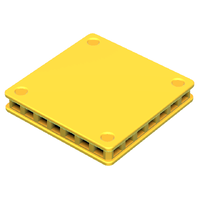 Artwork from Captain Toad: Treasure Tracker | |
| First appearance | Donkey Kong (1981) |
| Latest appearance | Mario vs. Donkey Kong (Nintendo Switch) (2024) |
Lifts[1][2] (also known as elevators)[3][4] are thin platforms that appear throughout the Super Mario franchise. They typically are suspended in the air and move, enabling the player character or to reach different heights and cross gaps. Some move by themselves, while others are controlled by the player.
Lifts that move along wire-like tracks in the Super Mario and Yoshi's Island series are sometimes referred to as Flatbed Ferries.[5]
History[edit]
Donkey Kong[edit]
In Donkey Kong, two sets of lifts appear in 75m: one set going up, the other set going down. Lifts appear to work via a chain-like mechanism. When an elevator reaches the end of its path, it disappears, and a new one appears at the beginning of the path, as opposed to a single elevator going up and down.
Lifts also appear in the Game Boy version of Donkey Kong. Levers can be pulled in certain levels to make them change direction.
Super Mario series[edit]
Super Mario Bros. / Super Mario Bros.: The Lost Levels[edit]
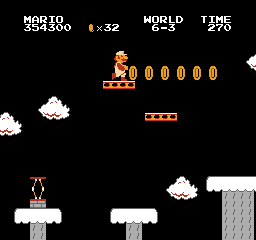
Lifts are common in some levels of Super Mario Bros. Vertical Lifts[6] first appear in World 1-2, where they continuously move upwards or downwards with new ones being dispensed from the bottom or top. World 1-3 introduces a version of this lift that remains onscreen and simply moves up and down, as well as Horizontal Lifts[6] that move back and forth. World 3-3 introduces Flimsy Lifts, which are stationary lifts that move downwards if Mario or Luigi stands on them, as well as Balance Lifts. Balance Lifts consist of two platforms attached to a pulley, where if Mario/Luigi stands on one of them, that lift is weighed down, while the other is hoisted upwards. However, if Mario/Luigi stands on said lift too long, and the lift he is on moves too far down due to his weight, then both lifts will break off the pulley and fall into the void below, causing Mario/Luigi to score 1,000 points, oddly enough. The lifts are solid, meaning Mario and Luigi cannot land on top by jumping through them. Their original visual appearance in Super Mario Bros. is likely derived from the appearance of the platforms that make up 100m in Donkey Kong, while, in Super Mario Bros.: The Lost Levels, they are made of mushrooms. However, in the Super Mario All-Stars version, both games feature them in their normal form.
Super Mario Bros. 3 / Super Mario Advance 4: Super Mario Bros. 3[edit]
In Super Mario Bros. 3, lifts are made of wood, much like Hard Blocks in the game. Two new varieties are introduced: Rail Lifts,[7] which travel along a track, first appearing in World 1-6, and moving Flimsy Lifts, which fall all the way to the bottom of the screen as soon as Mario or Luigi lands on one, first appearing in World 1-4. In Super Mario Advance 4: Super Mario Bros. 3, Super Mario Bros.-styled metallic lifts of various types are found in the World-e levels Wild Ride in the Sky, Caped Escape, Koopaling Confusion, Classic World 1-2, Classic World 1-3 and Classic World 1-4, while several stationary lifts in their Super Mario World design can be seen in the level Rich with Ropes. In A Towering Tour, some fast-moving gray-colored lifts also appear. They behave similarly to the metal lifts, only being shaped like the normal lifts, and the aforementioned color difference. They also follow a shorter path compared to normal lifts, which adds to the difficulty of staying on top of them. These blocks also have a line-guided variant, which move even faster than their non-line-guided variants.
Super Mario World / Super Mario World: Super Mario Advance 2[edit]
Lifts reappear in Super Mario World and its reissue, this time with a gray or cream color. The Rail Lift is back under the name Pulley Lift[8] (or Pully Lift).[9] A platform on a swing is known as a Single Swing Lift, coming with a brown version that activates and rotates around a central pivot point when a player steps on it and a gray version that swings in perpetual motion, as well as a set of three swinging gray platforms known as a Triple Swing Lift. A set of gray Rotating Blocks that cannot spin with wings is known as a Flying Platform. A raft of skulls on lava is known as a Skull Raft. An orange, diagonal-facing lift with a grassy top is known as a diagonal platform, and a thicker, upright grassy platform with a countdown timer in the middle is known as a Count-Lift. Additionally, a mushroom variant of the Balance Lift is known as a Piston Lift.
Super Mario Land 2: 6 Golden Coins[edit]
Super Mario Land 2: 6 Golden Coins introduces a Bone Lift that rises upward when jumped on, which is a hazard as the sole section of the game that includes them features spikes above them. They basically act as the opposite of the Flimsy Lift, although the Bone Lift freezes in place when Mario is off of it, unlike the Flimsy Lifts in this game.
Super Mario 64 / Super Mario 64 DS[edit]
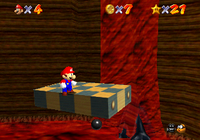
Most lifts in Super Mario 64 and Super Mario 64 DS have a tan-and-green checkerboard pattern on them. In some courses, such as Whomp's Fortress and Vanish Cap Under the Moat, pairs of lifts move along and rotate around both sides of a vertical beam, flipping when they reach the top. In the Hazy Maze Cave and Lethal Lava Land, lifts move along chains of black spheres when stepped upon. Additionally in the Hazy Maze Cave, large orange lifts with yellow and black trim appear to take the player between floors, and a unique controllable lift called the Work Elevator appears in one part of the course. Special lifts called Arrow Lifts appear in Wet-Dry World, moving back and forth when stepped upon. Also in Wet-Dry World, an Express Elevator appears embedded into some metal mesh. Stepping on the portion outside the mesh causes it to lower, at which point the player has a limited time to reach the portion inside the mesh and ride it to a Power Star. In Tick Tock Clock, yellow rectangular lifts move up and down; the speed and direction vary depending on the time Mario enters the course. Also, a brown cube that moves up and down serves as an obstacle during The Pit and the Pendulums, and Mario can step on it.
Super Mario Galaxy 2[edit]
In Super Mario Galaxy 2, lifts appear as yellow platforms that raise Mario up, then flash blue and disappear. They cannot be controlled by the player. They appear in Sky Station Galaxy, while giant versions of them are found in Supermassive Galaxy.
Super Mario 3D Land / Super Mario 3D World / Super Mario 3D World + Bowser's Fury[edit]
Lifts in Super Mario 3D Land, Super Mario 3D World, and Nintendo Switch version have the same design and function as in Super Mario Galaxy 2. However, they never disappear, unlike in the previous game.
Super Mario Maker / Super Mario Maker for Nintendo 3DS[edit]
Lifts in Super Mario Maker and its Nintendo 3DS version function as tools, and the direction in which they initially move can be pre-set, and they can move in a set path when placed on a track. When shaken, they turn into Flimsy Lifts, which are colored blue this time and will start moving on a track once stepped on. In the Super Mario World style, when placed on a track, the lift uses the same tile as the Chainsaw from that game, albeit with minor differences.
Super Mario Run[edit]
Lifts in Super Mario Run move on tracks in several levels. When Mario stands on a Lift, he stops moving until he jumps. After Mario gets off of a Lift, it disappears. The lifts' designs are similar to the falling platforms in the final Bowser battle in New Super Mario Bros. 2.
Super Mario Odyssey[edit]
Lifts (referred to as moving platforms in the Prima guide)[10] appear in varying designs and sizes in Super Mario Odyssey.
In the Tostarena Ruins in the Sand Kingdom, large stone ones depicting the Inverted Pyramid appear above a canyon after Mario collects the Power Moon for the mission Atop the Highest Tower and move along a track after he steps on them. These lifts transport Mario to Moe-Eye Habitat, which features smaller stone lifts that Mario must use to collect Moon Shards. Larger versions of these stone lifts appear in the sub-area with the Power Moon for the sidequest Jaxi Driver. The Inverted Pyramid lifts also appear in the Ice Cave sub-area, except they are darker-colored and topped with ice. Unlike other lifts, these ones rotate while moving.
Lifts that use their Super Mario Bros. sprites also appear in 2D segments. They appear prominently in the Cascade Kingdom sub-area with the Power Moon for the sidequest Past the Chasm Lifts, where they behave similarly to the lifts in World 1-2 of Super Mario Bros. while similarly shaped stone lifts appear outside the 2D segments and move continuously on tracks.
Super Mario Maker 2[edit]
Lifts also appear in Super Mario Maker 2, where this time, their length can be changed. In the Super Mario 3D World style, they take the form of Cloud Lifts.
Donkey Kong Country series[edit]
Donkey Kong Country[edit]
Elevators in Donkey Kong Country seemingly filled with coal appear abundantly in the latter half of Elevator Antics. They move either up or down from a steel pole.
Donkey Kong Country 3: Dixie Kong's Double Trouble![edit]
Lifts in Donkey Kong Country 3: Dixie Kong's Double Trouble! are made up of wooden planks. Some are activated when Dixie Kong or Kiddy Kong ride them, and some are activated automatically. They are found primarily in mills, but also appear in Fire-Ball Frenzy and Rocket Rush. Additionally, a single horizontally moving lift appears during the first boss fight with Baron K. Roolenstein. In the Game Boy Advance version, lifts also appear in Dingy Drain-Pipe.
Yoshi's Island series[edit]
Flatbed Ferries, a special kind of lift, appear in every game of the Yoshi's Island series. When jumped upon, they typically follow a preset path marked by a track. When a Flatbed Ferry reaches the end of the line, blocked by a little red sphere, it switches its direction of movement; if the line ends without a sphere, the Flatbed Ferry falls down, but it may be "caught" by another track if it falls on one, and it starts following it.
Flatbed Ferries appear in a variety of colors, such as green, yellow, and red, with each getting progressively faster; in the isometric sections found in certain fortresses, the colors are a pale pink, periwinkle, and cyan. Magenta ones appear as part of paddle wheels. The liquid lift and Blarggwich carry green Flatbed Ferries.
Game & Watch Gallery 2[edit]
On the first and second stages of the Game & Watch Gallery 2 rendition of Donkey Kong, Flatbed Ferries appear as the last platforms Mario must use to reach the goal. In both instances, they are activated temporarily by flipping a switch. On the first stage, the Flatbed Ferry revolves around a point, similarly to a paddle wheel, and makes four 90-degree turns before completing one rotation. On the second stage, the platform swings from side to side on a chain in three positions. Flatbed Ferries are replaced in the Game & Watch Gallery 4 version by more thematically fitting platforms.
Yoshi's Story[edit]
Lifts in Yoshi's Story are featured in the form of smiling cloud platforms that move along tracks in the level Rail Lift. If a Baby Yoshi hits a switch present along the tracks by throwing an egg, the cloud platform can move to different tracks. Flatbed Ferries also return in the game.
Super Smash Bros. series[edit]
Super Smash Bros. Melee[edit]
A smiling cloud platform appears in the Yoshi's Story stage in Super Smash Bros. Melee, where it retains its appearance from Yoshi's Story, as well as its function as a lift. The cloud cycles across the stage along a dotted line, moving behind the center of the stage and emerging from the left and right sides of the stage. A fighter can use the cloud as a platform to recover from falling off of the stage.
Super Smash Bros. Brawl[edit]
In Super Smash Bros. Brawl, lifts from Donkey Kong appear in the stage 75 m, which also reappears in Super Smash Bros. for Wii U and Super Smash Bros. Ultimate. They act same as they do in the original Donkey Kong due to the stage being an exact remake of the original level. Lifts also appear in the Mushroomy Kingdom stage, with the same placement and function as in World 1-2 of Super Mario Bros., though they are pass-through platforms and appear as rusted, due to the stage's aged appearance.
Super Smash Bros. for Nintendo 3DS[edit]
In Super Smash Bros. for Nintendo 3DS, lifts from Super Mario 3D Land appear as platforms in the auto-scrolling 3D Land stage. The match begins on three stationary lifts. During the second portion, players fight on four multi-colored lifts as they transition them to the third portion of the stage; on the way there, some platforms may collide into protruding rocks, altering their angle. In PictoChat 2, one of the drawings that may appear is a row of blocks between a pair of continuously moving lifts from World 1-2 of Super Mario Bros.
Super Smash Bros. Ultimate[edit]
In Super Smash Bros. Ultimate, the smiling cloud platform returns in the Yoshi's Story stage, functioning identically to its appearance in Super Smash Bros. Melee.
Mario & Luigi: Superstar Saga / Mario & Luigi: Superstar Saga + Bowser's Minions[edit]
In Mario & Luigi: Superstar Saga and its Nintendo 3DS version, a lift that connects to Little Fungitown can be found at the end of Teehee Valley, and a couple of Lifts can be found in Guffawha Ruins. Also, the Spin Blocks, which can be found in Gwarhar Lagoon, were introduced in this game as well.
Mario vs. Donkey Kong series[edit]
Mario vs. Donkey Kong[edit]
Lifts similar to the ones from Donkey Kong appear in Mario vs. Donkey Kong. They continuously appear at one end of a track and move in a direction before disappearing at the other end. Sometimes, the direction of all lifts in a level can be changed at once by pressing a Direction Switch. They also appear in its Nintendo Switch remake.
Mario vs. Donkey Kong 2: March of the Minis[edit]
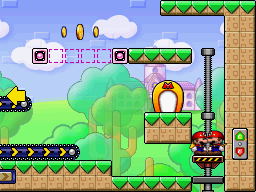
Two types of lifts, elevators and Moving Platforms[11] (also known as Path Platforms),[12] appear in Mario vs. Donkey Kong 2: March of the Minis.
Elevators are introduced in Room 1-5 of Mushroom Mayhem, and continue to appear in later levels in the game. They are platforms attached to a pole. A control panel[13] is attached to a wall next to each elevator, with two red buttons resembling arrows pointing up and down. Up to two Minis can walk on an elevator's platform. The player can tap the buttons on the elevator's control panel using the stylus to raise or lower the elevator's platform. Once a button is pressed, it turns green and the platform starts moving. The platform's direction cannot be changed again until it reaches the end of the elevator's pole or a height where it is adjacent to ground. Minis will remain on an elevator's platform until their direction is changed using the stylus.
Moving Platforms are introduced in Room 6-3 of Toadstool Castle. They move automatically along a predetermined path. Whenever they reach a ledge, they stop for a short time and their platform extends slightly. A single Mini can board a Moving Platform while its platform is extended. Unlike elevators, only one Mini at a time can board a Moving Platform.
WarioWare series[edit]
Lifts on tracks from Super Mario Bros. 3 appear in the microgame Super Mario Bros. 3-Lift in WarioWare: Twisted! and WarioWare Gold (renamed to simply "Super Mario Bros. 3" in the latter). The player has to rotate the system to move the platforms and make Mario avoid the multiple enemies coming for him. In the third level, another lift appears along with Luigi on it, who also needs to be protected.
Yoshi Topsy-Turvy[edit]
Lifts can be used by Yoshi in Yoshi Topsy-Turvy, along with a small version called Half Lifts (ハーフリフト).[14] They come in a green zig-zag pattern and a brown rocky pattern and are attached to chains, sometimes along rails. When the player tilts their Game Boy Advance system, the lifts will swing back and forth and move along the rails. The brown ones are old and worn-out, causing them to fall at the end of a rail.
Super Paper Mario[edit]
In Super Paper Mario, lifts adopt the yellow and orange zigzag pattern found on loading zones from the previous Paper Mario entries. Horizonal and vertical lifts serve as platforms to reach high or far away areas in Yold Desert, the Floro Caverns, The Overthere and other locations. A variation of these platforms appear in The Bitlands, where they are pixelated and resemble the design from Super Mario Bros. The underground segment also features vertical lifts which mimic the scrolling behavior from said game. Black lifts with white outlines appear in the Castle Bleck Inner Sanctum.
Captain Toad: Treasure Tracker (Nintendo Switch)[edit]
Lifts reappear in the Nintendo Switch version of Captain Toad: Treasure Tracker, replacing the Propeller Platforms due to the lack of the microphone.
Mario Kart series[edit]
Mario Kart Tour[edit]
In Mario Kart Tour's Battle Mode, any opponents that are eliminated ride on lifts that move around the course and throw projectiles such as Green Shells, Bananas, and Bob-ombs onto the course.
Mario Kart 8 Deluxe[edit]
A pink Flatbed Ferry, with a Yoshi sitting on it, appears near the starting line of Yoshi's Island in the Booster Course Pass DLC pack for Mario Kart 8 Deluxe.
The Super Mario Bros. Movie[edit]
Lifts make an appearance in The Super Mario Bros. Movie, where they resemble and behave the same way they do in Super Mario 3D Land and Super Mario 3D World.
List of lifts[edit]
Lifts in the Super Mario franchise are the basis of many other platforms. For many of them, this is apparent with the inclusion of リフト ("Lift") in their Japanese name, which is not always carried over during localization. Most derived lifts are suspended in the air and move, either on their own or when a player character steps on them.
- Arrow lift (New Super Mario Bros. series)
- Arrow Lift (Super Mario 64)
- Arrow wheel
- Ball on chains
- Balloon Bully
- Big Windmill
- Blarggwich
- Blarggwich (sandwich)
- Bolt Lift
- Bone Lift
- Chairlift
- Cloud Lift
- Count-Lift
- Cross Lift
- Diagonal platform
- Directional Lift
- Disappearing platform
- Donut Lift
- Dropdown Countdown Lift
- Elevator lift
- Eye Beamer
- Flimsy Lift
- Floating barrel
- Floating couch
- Flying Platform
- Hip Drop Move Lift
- Lava Lift
- Liftoglobin
- Limited Lift
- Linking Lift
- Liquid lift
- Moving block
- Multi-Vator
- Paddle Platform
- Pendulum Platform
- Pinwheel
- Propeller Platform
- Puffy Lift
- Raft
- Remote-Control Platform
- Remote-Controlled Lift
- Rotary Lift
- Rotating Panel
- Scale Lift
- Screwtop Lift
- Screwtop Shroom
- Seesaw
- Segmented platform
- Single Swing Lift
- Sky Move Lift
- Slide Lift
- Slow falling platform
- Spine Coaster (Super Mario 3D Land)
- Star Lift
- Stretch Shroom
- Swing
- Tilt Lift
- Transparent Lift
- Triple Swing Lift
- White box
- Wire Net Platform
- Work Elevator
- Zipline lift
Profiles[edit]
Rail Lift[edit]
Super Mario Bros. 3[edit]
- 3DS Virtual Console manual bio: "Travel along rails."
Gallery[edit]
Artwork[edit]
Sprites and models[edit]
Super Mario World (Pulley Lift)
Super Mario All-Stars (Super Mario Bros.)
Super Mario World 2: Yoshi's Island (Flatbed Ferry)
Yoshi's Story (Flatbed Ferry)
Yoshi Topsy-Turvy (Flatbed Ferry)
Super Mario Maker (Super Mario Bros. 3-style)
Super Mario Maker (New Super Mario Bros. U-style)
Screenshots[edit]
Names in other languages[edit]
Lift[edit]
| Language | Name | Meaning |
|---|---|---|
| Japanese | リフト[15] Rifuto エレベーター[16] Erebētā |
Lift Elevator (Mario & Wario) |
| Chinese | 升降梯 Shēngjiàngtī 升降台 (Super Mario Maker 2) Shēngjiàng Tái |
Lift Lift |
| Dutch | Platform |
Platform |
| French | Plateforme Ascenseur[19] |
Platform Elevator |
| German | Lift[18] |
- |
| Italian | Ascensore Piattaforma |
Elevator Platform |
| Russian | Платформа Platforma |
Platform |
| Spanish | Ascensor Elevador[17] |
Elevator Elevator |
Flatbed Ferry[edit]
| Language | Name | Meaning |
|---|---|---|
| Japanese | せんリフト Sen Rifuto 線リフト[20] Sen Rifuto レールリフト[21] Rēru Rifuto |
Track Lift Track Lift Rail Lift (Super Mario Bros. 3) |
| Korean | 줄리프트 Jul Ripeuteu |
Line Lift |
| Spanish (NOE) | Transbordador |
Ferry |
References[edit]
- ^ Pelland, Scott; Owsen, Dan (1996). Super Mario 64 Player's Guide. Redmond, WA: Nintendo of America. Page 58.
- ^ Super Mario Maker in-game name
- ^ Musa, Alexander; Hatchett, Geson (November 22, 2013). Super Mario 3D World PRIMA Official Game Guide. Prima Games (American English). ISBN 978-0804162494. Page 167.
- ^ Mario vs. Donkey Kong 2: March of the Minis in-game help (no. 08)
- ^ "Stand on the Flatbed Ferry platform above this first Star Coin, and wait for the Flatbed Ferry to slide to the right." – Stratton, Steve (2012). New Super Mario Bros. U: PRIMA Official Game Guide. Roseville: Prima Games. ISBN 978-0-307-89690-2. Page 68.
- ^ a b Tochikubo, Hiroo (1987). How to win at Super Mario Bros.. Tokuma Shoten. ISBN 4-19-720003-XC. Page 47..
- ^ Super Mario Bros. 3 English instruction booklet. Page 19.
- ^ Nintendo of America staff (August 1991). Mario Mania. Nintendo Power (American English). Page 70 and 71.
- ^ (2002). Nintendo Power Advance Volume 4. Nintendo of America (American English). Page 29.
- ^ Walsh, Doug; Epstein, Joe (October 27, 2017). Super Mario Odyssey Prima Official Guide. Prima Games (American English). ISBN 978-0744018882. Page 54, 59, 68, 71, 73.
- ^ Mario vs. Donkey Kong 2: March of the Minis in-game help (no. 20)
- ^ Mario vs. Donkey Kong 2: March of the Minis object graphics filename (data/anims/path_platform_anim.bin)
- ^ Nintendo. Mario vs. Donkey Kong 2: March of the Minis instruction booklet. Nintendo of America. Page 21. Retrieved July 31, 2022.
- ^ 「ヨッシーの万有引力任天堂公式ガイドブック」 (Yoshi Banyū Inryoku Nintendo Kōshiki Guidebook. Shogakukan (Japanese). Page 20.
- ^ Sakai, Kazuya (Ambit), kikai, Akinori Sao, Junko Fukuda, Kunio Takayama, and Ko Nakahara (Shogakukan), editors (2015). 『スーパーマリオブラザーズ百科: 任天堂公式ガイドブック』. Tokyo: Shogakukan (Japanese). Page 21, 29, 41, 48, 61, 78, 92, 119, 137, 151, 171, 186, 201, 217, 234.
- ^ Nintendo (1993). Mario & Wario instruction booklet. Nintendo. Page 9.
- ^ Mario vs. Donkey Kong European instruction booklet. Page 98.
- ^ Mario vs. Donkey Kong European instruction booklet. Page 38.
- ^ Mario vs. Donkey Kong European instruction booklet. Page 58.
- ^ ---- (2015). 『スーパーマリオブラザーズ百科: 任天堂公式ガイドブック』. Tokyo: Shogakukan (Japanese). Page 60, 118, 150, 200, 216.
- ^ Nintendo (1988). Super Mario Bros. 3 Japanese instruction booklet. Nintendo (Japanese). Page 17.
- Platforms
- Hazardous objects
- Donkey Kong (game) objects
- Donkey Kong (Game Boy)
- Donkey Kong Country objects
- Donkey Kong Country 3: Dixie Kong's Double Trouble! objects
- Mario & Wario
- Mario Kart Tour objects
- Mario vs. Donkey Kong objects
- Mario vs. Donkey Kong 2: March of the Minis
- Super Mario Advance 4: Super Mario Bros. 3 objects
- New Super Mario Bros. objects
- New Super Mario Bros. 2 objects
- New Super Mario Bros. U objects
- New Super Mario Bros. Wii objects
- Super Mario 64 objects
- Super Mario 64 DS objects
- Super Mario 3D Land objects
- Super Mario 3D World objects
- Super Mario Bros. objects
- Super Mario Bros. 3 objects
- Super Mario Bros.: The Lost Levels objects
- Super Mario Bros. Wonder objects
- Super Mario Galaxy 2 objects
- Super Mario Maker objects
- Super Mario Maker 2 objects
- Super Mario Odyssey objects
- Super Mario Run objects
- Super Mario World objects
- Super Mario World 2: Yoshi's Island objects
- Super Paper Mario objects
- Super Princess Peach objects
- Super Smash Bros. Brawl
- Super Smash Bros. for Nintendo 3DS / Wii U
- The Super Mario Bros. Movie objects
- Yoshi Topsy-Turvy objects
- Yoshi's Island DS objects
- Yoshi's Island: Super Mario Advance 3
- Yoshi's New Island objects
- Yoshi's Story objects
